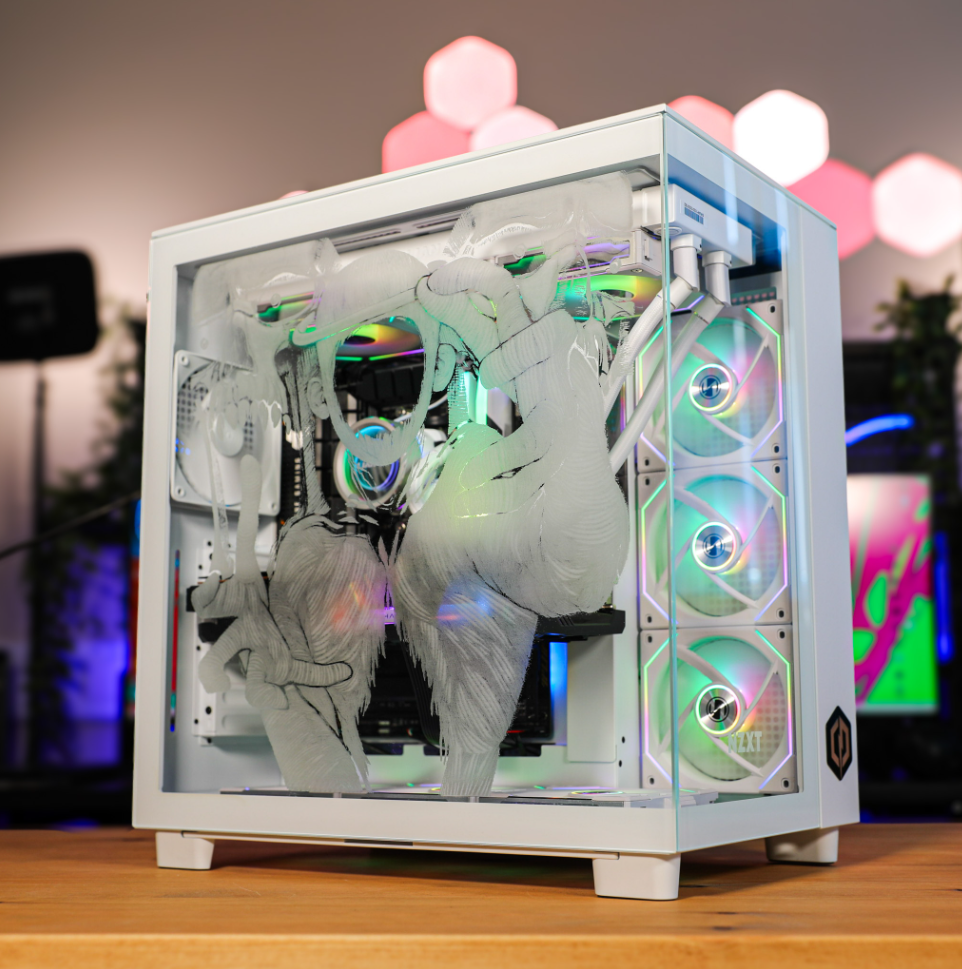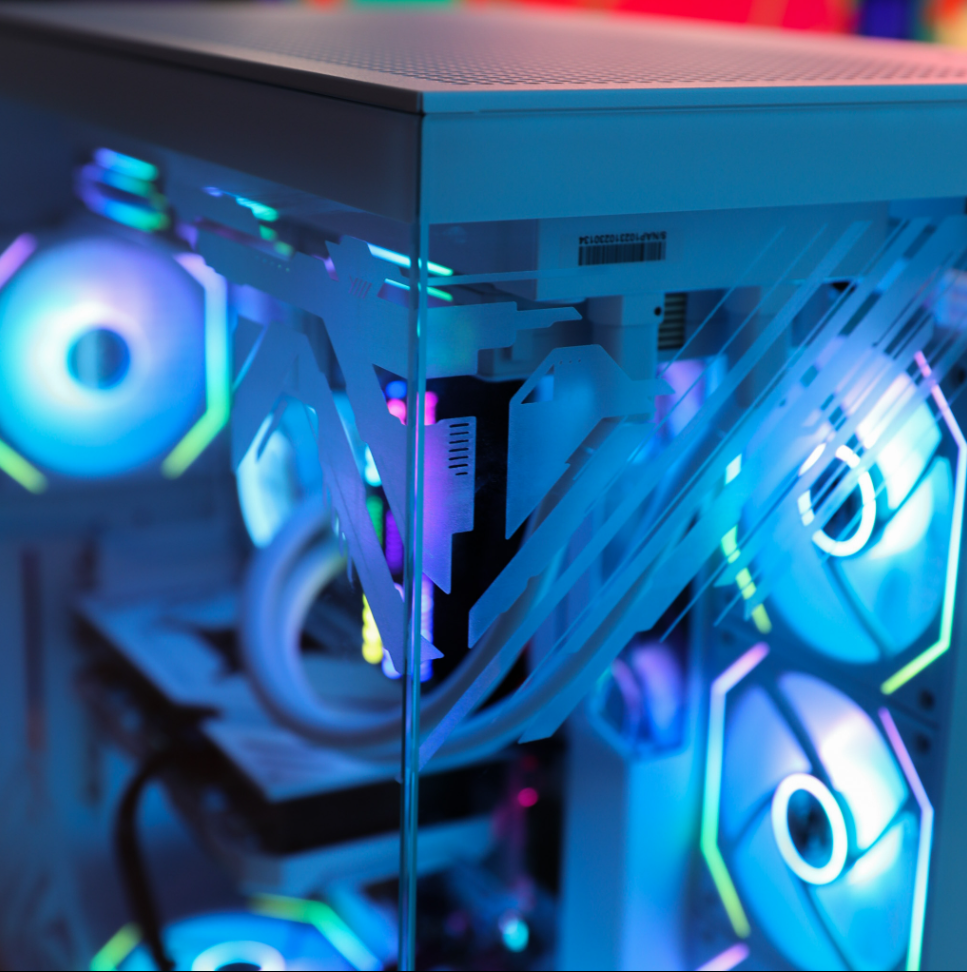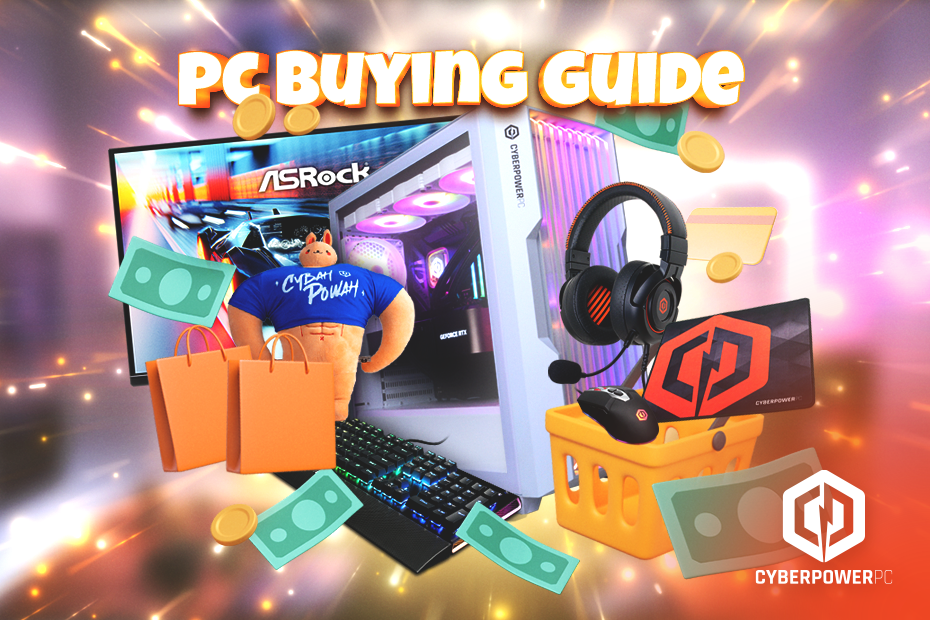Where to Start?
We’ve all been there: You want to get a new PC but don’t know where to start. Well, don’t worry; the CyberPowerPC UK buying guide is here. This guide will help you decide what’s right for you.
So the real question is, where do you start? First, set your budget for what you’d like to spend. By doing this first, you can eliminate options that don’t fit your price range. Prices for a PC can range from £500 to £5K+. We’re not shy of options for you to choose from, and if you contact our customer support team, they will be able to fit your needs!
The next question is, what are you using your new PC for?
The main categories that PC usage falls into are:
- Gaming – Preferably, having a gaming PC to boost game performance would be good.
- Casual Use—There is no need for an expensive setup; a mid-range setup is fine. Our Next Day PCs are great for this!
- School or work—Depending on the school work, a Laptop would work great here as it’s mobile and still has everything you need.
- Streaming, Content Creation, Editing, and Rendering—I recommend getting a custom set-up, as you will need a stronger GPU to handle these tasks.
Each of these categories requires a different type of hardware. For example, a heavy gaming machine will cost more than one for school or work. This is because the components are more powerful when running games of the highest quality.
Once you’ve decided which categories your usage falls under, you can start looking at which components will best suit your needs.
CPU

The CPU is the heart of your PC and arguably the most important component. Like every component, the price scales with the chip’s performance. The better the performance, the more money the chip will cost. Each CPU also excels at different tasks; some are better at gaming, others better at workload, and then you have the all-around performers.
Here are our hot takes on the CPUs that would work best for you!
- Want faster Gaming?
For the fastest gaming CPU on the market, we’d recommend the latest Intel i9. Intel prides itself on having the fastest CPU on the market, and it doesn’t come cheap. But for serious gamers who need the absolute best performance, it’s worth the investment. We would also recommend an AMD Ryzen 9 for more power efficiency! - Mid-Range Gaming
You will want to look at the Intel i5 and i7 range and AMD Ryzen 5 or 7 for mid-range gaming. Both ranges are the perfect middle ground for the price to perform. You won’t get as good a performance as an i9 or Ryzen 9 or an , but they will still play every game flawlessly. - Casual Gaming
These CPUs are best if you want to do a small amount of gaming on the side and are a great budget option. Our recommendation would be to go with a low-end AMD Ryzen. Despite the generational gap, the performance is still strong, meaning you can game on the side of your other responsibilities. In addition, the price is much lower than the newest Ryzen CPU on the market. - Productivity
If you want the fastest CPU for productivity, then you’ll want the AMD Threadripper Pro. This range of CPUs is an absolute workhorse; not only does it do well with productivity, such as video rendering, but it also destroys the gaming side of things. AMD’s CPUs generally are the best for productivity due to their enormous amount of threads and cores, and the newest series will work the best.
Motherboard

Regarding motherboards, the only thing you have to get your head around is the compatibility.
What is the difference between a low-end and high-end motherboard?
Firstly, a higher-end motherboard is more compatible with higher-quality components. Why? Suppose you’re running a powerful but hot CPU; if connected to a low-end motherboard, the capacitors are likely to break. It would be like putting an F1 engine in your everyday car. It can work if built correctly, but you could run into issues down the line due to the difference in the performance of the parts. The first thing to do is decide which brand of CPU you want; this will determine which motherboard you require. Our website helps you out so you can’t choose something incompatible.
Cooling

Cooling products prevent your system from overheating. There are several options, and we’ll walk you through them and their benefits, starting with the lowest price and going up to the most expensive.
- Stock cooler
A stock cooler is a cooling fan that comes with your CPU. These coolers do the job for casual use, but don’t expect low temperatures whilst gaming; we’d recommend one of the options below if you want to game. These coolers are best used in office PCs and day-to-day machines, like for emails and internet browsing, which means they are under much less stress. - Tower Cooler
Tower coolers are one of the older forms of cooling, but they still hold up today. A tower cooler is a big piece of metal with a fan attached, stuck onto your CPU. It absorbs heat from the CPU and redistributes it away from the hardware. The fan lines up with the exhaust fan on your machine, which takes the hot air out of the case. Still, I’d look at the next section for the best choice. - AIO Cooler
AIO (all-in-one) coolers are the standard cooling option today. They work similarly to tower coolers, but instead of a colossal heatsink, they use a copper block, liquid, and a radiator to redistribute the heat. The liquid absorbs the heat from the CPU and runs through a closed loop until it reaches the fans on the radiator, which expels the heat out of your PC—keeping your CPU nice and cool.
AIOs can have different-sized radiators. The most common ones are 120mm, 240mm, and 360mm. The general rule is that the larger the radiator, the better the cooling performance. Our recommendation to keep your PC cool is a 240mm AIO. - Custom Loop
Custom loops work the same as an AIO but allow users to add as much liquid and radiators as they want, meaning better performance. Also, you can cool your graphics card with this option. This is by far the most expensive cooling option. Still, it allows you to put your spin on your build by shaping the loop around your components, meaning each custom loop is unique. It’s also the most complicated option to install. Still, when built by our CyberPowerPC experts with years of experience, you are guaranteed your PC will be in good hands.
RAM

Random Access Memory, commonly known as RAM, stores temporary data while you’re working on your PC. Depending on your PC use, you’ll need more RAM for specific tasks than others.
Why does the speed of your RAM matter?
The faster the speed, the less RAM it takes to receive a request from the processor and then read or write data. However, this doesn’t mean you can pair the quickest RAM with any CPU. Again, like everything with PCs, it comes down to compatibility, so check what speed you need by checking your CPU specs for what it supports. You can put higher speeds than recommended, but depending on your motherboard, it can make your system unstable and cause crashes.
The minimum amount of RAM you will need is 8GB, perfect for daily browsing, creating documents, and some light gaming. Suppose gaming is the main reason for buying your system; in that case, 32GB is currently the perfect amount to run any game without any issues. For editing, rendering, and general intensive tasks, you’ll need more than 32GB; anywhere from 64GB would be the perfect amount.
Graphics Card (GPU)

The GPU is the second most crucial component in your PC, especially for gaming or rendering images and video. It determines how quickly your game renders. In simple terms, the better the GPU, the better the performance for gaming and rendering.
There are many model and generation options for GPUs, but the two names you need to remember are NVIDIA GeForce RTX and AMD Radeon. To get the most out of AAA games, many gamers choose a GPU that supports Ray Tracing— emulating real light rays and using an algorithm to trace the path that actual light would take in the real world.
We’d recommend the latest RTX GPU if you’re interested in this. Although AMD Radeon does support Ray Tracing, the RTX series is seen as the better option for this feature, but it can come with a hefty price tag. If you’re not fussed with Ray Tracing but care about the performance-to-price ratio, we’d suggest investing in an AMD Radeon GPU.
Power Supply (PSU)

The PSU supplies power to your whole system. When choosing a PSU, consider its wattage and efficiency.
- Ratings
The rating describes the energy efficiency of the PSU; the higher the rating, the more efficient the PSU is. A high-efficiency PSU will use less power, generate less heat, and be more reliable than a low-efficiency PSU. The type of PSU you choose will depend on your specific needs. However, a PSU with a high-efficiency rating is always best, regardless of your needs.
We provide PSU ratings of 80+, 80+ Gold and 80+ Platinum. - Wattage
Wattage is one of the most important factors when buying a PSU, as it determines how much power the unit can handle. A high-wattage PSU doesn’t necessarily mean high quality; likewise, a low-wattage PSU can still be high quality. However, wattage is still essential, impacting how much power your system can draw from the PSU. For example, if you are building a high-end Gaming PC, you will need a PSU with a higher wattage to support all components.
As a rule of thumb, you should always have a PSU that produces more power than you need for two reasons. Reason 1: PSUs are most efficient when under 50% to 75% load. Reason 2: it leaves you enough room to upgrade PC parts in the future without replacing the PSU.
Case

Now that all the main components are out of the way, it’s time to look at cases. There are four sizes: Small Form Factor, Mid Tower, Full Tower, and Super Tower. Each one has its benefits.
- Small Form Factor (SFF)
SFF cases are great for saving space. They are usually the same size as your average game console and are great for casual gamers and work tasks. Nevertheless, hard-core gaming and intensive tasks can run hot since all the components are crammed into a small space. - Mid Towers
Mid-tower cases are the most common cases on the market. They are small enough to place on your desk without taking up a lot of space but big enough to hold larger GPUs. Be aware that not all components fit in every case. Still, our website will let you know if you have chosen any components that are not compatible with a mid-tower case. - Full Towers
The full tower lets you use any size of components without worrying about space. These cases are great for having on your desk but take up more space, so plan your setup to fit it in. - Super Towers
These cases are enormous and work best with custom liquid cooling, as you can fill the case out with the loops. Due to their size, they can look empty with some components. These cases are way too big and heavy to have on your desk, making them better on the floor.
Now you’ve decided what size case you’d like, it’s time to look at some aspects that apply to all sizes.
- Airflow
Airflow means how much air the case allows to be taken in; the more air the case brings in, the cooler your components will be. Your best option for airflow is a case with a mesh front, as this lets the air move freely into your system without much restriction. - Fans
Extra fans are great for keeping your system cool; as mentioned, airflow is vital. Adding more fans can introduce more air to your system and more efficiently exhaust hot air away from your components.
There are two types of fans: PWM and non-PWM. The only difference between the two is that you can control the speed of PWM, whereas non-PWM fans are set to constant full speed, which means they can be loud, and you can’t turn the speed down to reduce the noise. - Storage Space
If you’re adding many hard drives to your system, make sure your case accommodates them now and for any future storage upgrades. This is something you would do when looking at cases.
Storage

There are three types of storage: HDDs, NVMEs and SSDs. Each one has its perks.
- HDDs
HDD storage is often seen as the old-fashioned option for data storage, but that couldn’t be further from the truth. HDDs are still one of the best options for mass storage, especially for big games, movie and music libraries. And the best part is that they’re very cheap, meaning you could get double or triple the storage for the same price as a 1TB NVME. So, if you’re looking for a reliable and cost-effective storage solution, HDDs are your best bet. - SSDs
SSDs offer many benefits over HDDs. They are faster, more reliable, and longer-lasting. SSDs are the perfect option for gamers who want to load their files quickly and for video editors who need to write files to the drive quickly. If longevity is what you’re after, SSDs are for you. On average, SSDs have a 25% longer lifespan than HDDs and don’t break as easily as HDDs. SSDs are the superior choice for anyone who needs speed, reliability, or longevity. - NVME
NVMEs are the God Tier of storage devices. They offer amazing boot speeds, blistering quick read and write speeds and a longer life span than other types of storage. However, NVMEs are also more expensive than other types of storage, so we wouldn’t recommend using one as your primary storage device. However, using an NVME as a boot drive is a great way to improve your computer’s performance.
Extra
Braided cables and extensions
Braided cables are a neater and more durable alternative to standard cables. They help improve airflow and keep your hardware cooler. You can find braided cables and extensions for everything from your motherboard and VGA cards to hard drives and power supplies. Ditching your standard PSU cables for excellent-quality cables can take your build to the next level. Plus, you can now get an RGB cable extension, adding flair to your system.
RGB
RBG has taken the world by storm in just a few short years. What started as a simple way to add a bit of flair to gaming rigs has quickly become an obsession for many PC enthusiasts. These days, you can find RBG variants of just about anything, from cables and fans to GPU backing plates. The best part is that you can easily change the colour scheme of your entire build with the click of a button. CyberPowerPC UK provides a range of RBG options, from budget-friendly to a full Corsair’s iCUE RGB System.
Custom Engraving


A custom-engraved PC is the perfect way to make your machine truly yours. Whether you want to add a personal message or choose from one of our designs, engraving your PC is a great way to add a personal touch. Our team of experts can help you select the perfect design and font to make your machine stand out from the crowd.
Conclusion
Building a PC can seem complicated, but with the help of this guide, it’ll be a breeze. Choose components that suit your needs, and once it’s all done, you can sit back and relax, knowing that you’ve created a machine that will fulfil your computing needs for years.
Our website is fully optimised to ensure compatibility between components, so if you’re unsure, go ahead and add it in—the system will alert you to any issues. If you’d like extra guidance, feel free to contact us to walk through your build step-by-step with one of our dedicated customer service advisors.
Are you looking for a system and need it in a hurry? Why not check out our next-day systems? When ordered before 2 p.m. (Monday through Friday), these systems will be at your door by the next working day.
Looking for an experienced team to help you build your Custom PC? Look no further than CyberPowerPC UK. We have experts who can help you choose the right parts and put everything together so that you’ll be ready to go when you turn on your new computer.
